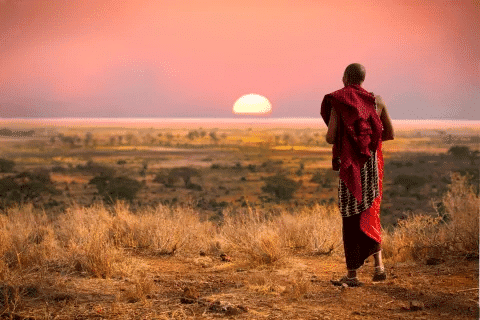Environment and Ecology: January 2025 UPSC Current Affairs | Environment for UPSC CSE PDF Download
| Table of contents |

|
| Golden Langur |

|
| Brazilian Velvet Ant |

|
| IPBES Transformative Change Assessment |

|
| Tribal Ministry’s Directive on Forest Right Act, 2006 |

|
Golden Langur

Why in News?
The recent death of a Golden Langur in an accident on National Highway 117 in Assam has raised significant concerns regarding the escalating threats faced by this endangered species.
Key Takeaways
- The Golden Langur is a species of primate found primarily in Assam, India, and parts of Bhutan.
- It is classified as endangered due to habitat fragmentation and various human activities.
Additional Details
- Taxonomy: The species name is Trachypithecus geei, belonging to the family Cercopithecidae (Old World Monkeys) and the subfamily Colobinae (leaf-eating monkeys). It was discovered by E.P. Gee in 1953 and formally described by Khajuria in 1956.
- Geographic Range: Golden Langurs are exclusively found in a restricted area in Assam, bordered by Bhutan's foothills to the north, the Manas River to the east, the Sankosh River to the west, and the Brahmaputra River to the south.
- Habitat: They inhabit subtropical and temperate broadleaf forests, thriving at elevations from near sea level to above 3,000 meters.
- Physical Characteristics: They are recognized by their golden-orange fur, which changes color with the seasons; cream in summer and dark golden in winter. They have a black hairless face with a pale beard and a distinctive hair whorl on the crown.
- Behavior: Active during the day (diurnal) and primarily arboreal, these langurs live in troops of 3 to 15 individuals, typically consisting of one male with multiple females or occasionally all-male groups.
- Threats: The fragmentation of their habitats due to human activities such as road construction and deforestation presents a major threat to their survival.
- Conservation Status: The IUCN Red List categorizes the Golden Langur as endangered, and it is protected under CITES Appendix I as well as the Wildlife Protection Act of 1972 (amended in 2022), which lists it in Schedule I to ensure stringent protection measures.
- Conservation Measures: Strategies include creating corridors to connect fragmented habitats and building canopy bridges for safer movement, along with the necessity for long-term conservation efforts to mitigate human impacts.
In conclusion, the Golden Langur faces numerous challenges due to habitat loss and human interference. Efforts to conserve this species are critical for maintaining biodiversity and ensuring its survival in the wild.
Brazilian Velvet Ant

Why in News?
A recent study in the Beilstein Journal of Nanotechnology highlighted the Brazilian velvet ant (Traumatomutilla bifurca), which possesses "ultrablack" body parts that absorb over 99.5% of visible light, rendering them nearly invisible. This discovery underscores the unique biological nanostructures present in the species, which could have potential technological applications.
Key Takeaways
- Taxonomy: Velvet ants are not true ants; they belong to the wasp family Mutillidae and are classified under the order Hymenoptera, which includes bees and wasps.
- Visual Characteristics: Some species, including Traumatomutilla bifurca, exhibit distinct black and white markings that make them visually striking in their native habitats, such as tropical savannas and dry shrub deserts.
Additional Details
- Ultrablack Property: Female velvet ants are characterized by their ultrablack coloration, first observed in this species. This coloration absorbs nearly all visible light due to special microstructures in their exoskeleton that trap light. This ultrablack pigmentation aids in camouflage, temperature control, and attracting mates.
- Sexual Dimorphism: Only female velvet ants exhibit this ultrablack coloration; males have similar black markings but reflect more light, making them less effective at camouflage.
- Ecological Role: These ants play a vital role in their ecosystem as pollinators, contributing to ecological balance.
- Evolutionary Significance: The ultrablack property is an example of convergent evolution, wherein unrelated species develop similar traits. This adaptation is also noted in species like birds-of-paradise and deep-sea fish, enhancing their camouflage and survival.
- Potential Applications: The ultrablack property offers insights into biological nanostructures and may inspire advancements in stealth technology and improvements in solar panel efficiency.
The study of the Brazilian velvet ant not only reveals fascinating aspects of its biology but also opens avenues for technological innovations, showcasing the interplay between nature and science.
IPBES Transformative Change Assessment

Why in News?
A recent report from the Intergovernmental Science-Policy Platform on Biodiversity and Ecosystem Services (IPBES), titled Transformative Change Assessment, emphasizes the vital role of governance in addressing biodiversity loss. It underscores that effective governance, which prioritizes inclusivity and sustainability, is crucial for maintaining biodiversity and fostering long-term systemic changes.
Key Takeaways
- Prevent Ecological Damage: Urgent shifts in societal interactions with nature are necessary to avoid biodiversity loss, as inaction could result in irreversible ecological damage, including the disappearance of coral reefs and rainforests.
- Economic and Employment Opportunities: Taking immediate action could create USD 10 trillion in business opportunities and support 395 million jobs globally by 2030, particularly in nature-dependent industries.
- Causes of Biodiversity Loss: The report identifies key causes such as the disconnection between humans and nature, the dominance over natural systems, concentration of power and wealth, and prioritizing short-term material gains over sustainability.
Five Key Strategies for Transformation
- Conserve and Regenerate: Focus on biocultural diversity areas that blend environmental restoration with cultural values, exemplified by community-driven forest management in Nepal.
- Systematic Change in Key Sectors: Implement sustainable practices in sectors like agriculture, fisheries, and infrastructure that impact biodiversity.
- Transform Economic Systems: Move towards nature-positive economies by reforming harmful subsidies and advocating for sustainable business models.
- Adaptive Governance: Develop governance systems that involve diverse stakeholders, including Indigenous communities, making biodiversity a central policy focus to adapt to changing environmental conditions.
- Shift Views and Values: Foster an understanding of human-nature interconnectedness through education, experiential learning, and the integration of various knowledge systems.
What is Transformative Change and How Can it be Achieved?
Transformative Change: It refers to a fundamental, system-wide reorganization across technological, economic, and social dimensions, including paradigms, goals, and values, which is essential for biodiversity conservation, sustainable usage, and achieving a high quality of life and sustainable development.
Steps to Achieve Transformative Change
- Carbon-Neutral Actions: Aim for carbon neutrality as a standard for individuals, businesses, and governments, while supporting credible climate-friendly offsets.
- Earth-Positive Choices: Facilitate enjoyable and accessible ways for individuals to positively impact the environment through shifts in supply chains and policy influences.
- Reforming Subsidies: Redirect subsidies and incentives to promote environmental stewardship and transition from resource-extractive industries to sustainable practices.
- Precautionary Decision-Making: Enact precautionary, adaptive, inclusive, and cross-sector decision-making to proactively address environmental threats, even without conclusive evidence.
- Strengthening Environmental Laws: Advocate for robust environmental legislation, ensuring consistent enforcement, and supporting global initiatives for nature protection and sustainable economic activities.
What are India’s Initiatives for Transformative Change?
- National Biodiversity Action Plan (NBAP)
- Swachh Bharat Abhiyan
- National Action Plan on Climate Change
- Faster Adoption and Manufacturing of Hybrid and Electric Vehicles (FAME)
- Pradhan Mantri Ujjwala Yojana (PMUY)
- Mission LiFE (Lifestyle for Environment)
- Atal Mission for Rejuvenation and Urban Transformation (AMRUT)
SDGs for Transformative Change
The Sustainable Development Goals (SDGs) aim for transformative change through inclusive growth, focusing on:
- Life Below Water
- Climate Action
- Clean Energy
- Clean Water
- Responsible Consumption
- Life on Land
Initiatives such as the Smart Cities Mission, Green India Mission, and the National Clean Energy Fund align with various SDGs. India has significantly invested in renewable energy, targeting a generation of 500 GW from non-fossil sources by 2030, supported by the International Solar Alliance.
Mains Question
Q: Discuss the concept of transformative change. How can this be implemented to address biodiversity loss and achieve sustainable development?
Tribal Ministry’s Directive on Forest Right Act, 2006
Why in News?
The Ministry of Tribal Affairs has directed states to establish Institutional Mechanisms to ensure compliance with the Forest Rights Act (FRA), 2006, in tiger reserves.
What are the Key Highlights of the Recent Directive By Tribal Ministry?
- Ensure FRA Compliance: The Ministry emphasized that forest-dwelling communities cannot be evicted without legal recognition of their rights under the FRA and Wildlife Protection Act, 1972.
- This move follows complaints of unlawful evictions from forest-dwelling communities, particularly in Madhya Pradesh, Maharashtra, and West Bengal.
- Consent for Relocation: Section 4(2) of the FRA provides safeguards that make it imperative to obtain free, informed consent of Gram Sabhas in writing for relocation. The law also provides for settlement rights in the areas where the settlement is proposed.
- States must submit a report detailing tribal villages in tiger reserves, and the status of their forest rights claims.
- The National Tiger Conservation Authority (NTCA) has also sought timelines for relocating 591 villages in tiger reserves, intensifying debates over balancing conservation with community rights.
- Grievance Redressal Mechanism: States are instructed to set up grievance redressal systems to handle complaints and grievances related to eviction from forest areas.
What are the Challenges in the Implementation of the Forest Rights Act, 2006?
- Lack of Recognition of Individual Rights: The recognition of individual rights under the FRA faces resistance from the Forest Department, which perceives it as a challenge to their control over forest resources.
- In Assam, shifting cultivation practices complicate the rights recognition process, while in Maharashtra's Gadchiroli district, community forest lands face threats of diversion for non-forest purposes despite progress in recognizing rights, revealing implementation gaps.
- Technological Issues: The implementation of digital platforms like VanMitra faces significant barriers due to poor internet connectivity and low literacy rates in tribal areas, making it harder to facilitate smooth processing of claims.
- Conflicting Legislations: The FRA often clashes with laws like the Indian Forest Act, 1927 and Wildlife Protection Act, 1972. These conflicts create ambiguities, with officials prioritizing traditional forest governance over FRA mandates.
- High Rejection Rates: Many claims are rejected due to a lack of proper documentation or evidence, often without clear explanations or opportunities for appeal. This leaves legitimate claimants without recourse.
- Underperforming Gram Sabhas: The Gram Sabha often lacks the capacity, resources, and training to perform its responsibilities effectively.
- Local elites within forest-dwelling communities often dominate decision-making processes, monopolizing the benefits and leaving marginalized groups without access to rights.
- Eviction and Development Conflicts: Despite FRA provisions, large-scale development projects like mining, dams, and highways often result in the eviction of forest-dwelling communities.
Way Forward
- Addressing Resistance: Form tribal or forest dweller bodies, like Farmer Producer Organizations (FPOs), to assert rights collectively, foster dialogue with forest departments, and align conservation with FRA objectives for sustainable management and empowerment.
- Amending existing laws like the Indian Forest Act, 1927, to reduce conflicts with the FRA and ensure clearer, cooperative governance.
- Improving Technological Capabilities: Focus on enhancing internet connectivity in tribal areas and providing training on digital platforms for smoother claims processing.
- Simplify documentation procedures to make the process more user-friendly while fostering digital literacy for comprehensive capacity building.
- Balancing Development and Community Rights: Ensure that large-scale development projects respect community rights and integrate sustainable practices to protect both forest communities and biodiversity.
- Establish frameworks to address conflicts between conservation and community empowerment by promoting co-management models.
- Inclusive Decision-Making: Ensure that decision-making within Gram Sabhas is inclusive, with marginalized groups such as women and lower castes having equal access to rights and benefits.
- Enhancing Awareness and Capacity Building: Launch widespread awareness campaigns to educate forest-dwelling communities about their rights under the FRA, enabling them to file claims.
- Build the capacity of Gram Sabhas with adequate resources and training to ensure effective decision-making and inclusion of marginalized groups.
|
95 videos|231 docs|52 tests
|
FAQs on Environment and Ecology: January 2025 UPSC Current Affairs - Environment for UPSC CSE
| 1. What is the significance of the Golden Langur in biodiversity conservation? |  |
| 2. What are the key characteristics of the Brazilian Velvet Ant? |  |
| 3. How does the IPBES Transformative Change Assessment address environmental issues? |  |
| 4. Why should UPSC aspirants focus on biodiversity and environmental conservation? |  |
| 5. What are the threats faced by the Golden Langur and Brazilian Velvet Ant? |  |




















